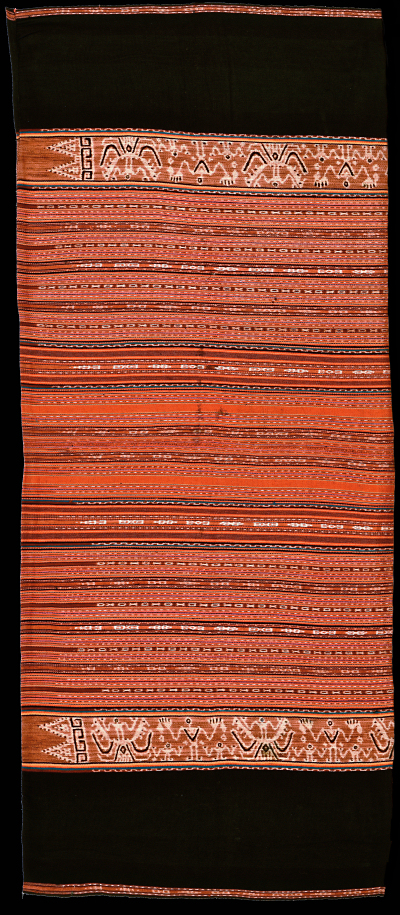| |
 
 | | | |
275 Moluccas, Kisar
Sarong  
| | Locale: | Probably Oirata people. | | Period: | Late colonial period. | | Yarn: | Cotton, hand-spun, medium - plus accent stripes in commercial cotton. | | Technique: | Warp ikat | | Panels: | 2 | | Size: | 65 x 163 cm (2' 1" x 5' 4") LW: 2.51 | | Design: | This sarong has the classic Kisar structure of a narrow ikated strip near the extremities, followed by a plain dark indigo band, followed by a main ikated band decorated with the classic rimanu pattern of the Kisar aristocracy and base-mounted tumpal motifs, followed by numerous narrow ikated bands. The wider ikated bands were done in hand spun cotton, the accent stripes in commercial cotton - as has been common on Kisar since about 1875. Rimanu motif shows human figures with upraised hands and in ships with sorsorlol (triple bow and stern extensions), a motif that is sometimes confused with 'double eagles', and is related to the motifs seen in Sumatran 'shipcloths'. | | Comment: | Some elements of the main ikated motif were decorated with dark lines in what appears to be indigo paste, thickly applied onto the finished surface probably by using a small stick. This kind of additional decoration has been seen elsewhere only once, on an early 20th c. Kisar sarong in the depot of the Frankfurt Weltkulturen Museum, the number of which unfortunately was lost. Ex collection J.H. L�th. For description of the ship motif, see PC 103. | | Background: | Chapters on Moluccas and Kisar. | | Exhibited: | Roemer Museum, Hildesheim (1991). | | Published: | Brigitte Khan Majlis, Woven Messages, 1991.
Ikat Textiles of the Indonesian Archipelago, 2018.
| | Compare: | 102 103 134 | | Sources: | Depicted in Brigitte Khan Majlis, Woven Messages, Fig. 311. Nico de Jonge in the 1981 photographed a Kisar cloth in Rumah Lewang Besar on Wetan, the most westerly of the Babar islands, which had been accentuated in the same manner. | | |

©Peter ten Hoopen, 2025
All rights reserved.
|
|


